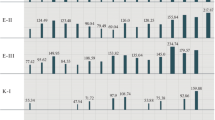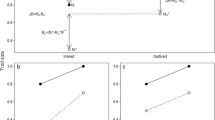Abstract
One of the main points of Mayr's ‘founder's principle’ is the role played by inbreeding in the first generations after the foundation of a population. To test this role, we studied 10 experimental populations of Drosophila melanogaster, each founded by one brother-sister pair; these sib pairs differed for their values of viability components of their F1 offsprings. The populations so formed were maintained en masse with non-overlapping generations. Under our uniform laboratory environmental conditions, the mean viability and within-family component of variance (measured on wing length) values of the first generations depended on the viability component values of the founders. After about twenty generations, all but one of these populations reached equilibrium values similar to those of the parental population. Moreover, the insertion patterns of the mdg-1 mobile element were analysed in the founded populations by in situ hybridization on polytene chromosomes. The patterns differed between the founded populations. More than forty generations were needed before movements of transposable elements reshaped the genome in a significant way. Although it is classically admitted that inbreeding resulting from founder event ultimately leads to extinction, our results show that once the first generations are over, the founded populations become firmly established and present the characteristics of the parental population.
Similar content being viewed by others
References
Ananiev, E. V., Gvozdev, V. A., Ilyin, Y. V., Tchurikov, N. A. & Georgiev, G. P., 1978. Reiterated genes with varying location in intercalary heterochromatin regions of Drosophila melanogaster polytene chromosomes. Chromosoma 70: 1–17.
Barton, N. H. & Charlesworth, B., 1984. Genetic revolution, founder effects, and speciation. Ann. Rev. Ecol. Syst. 15: 133–164.
Begon, M., Chadburn, R., Bishop, J. A. & Keill, C., 1985a. Genetic variation in a semi-natural Drosophila population after a bottleneck. I. Lethals, their allelism and effective population size. Genetica 66: 11–20.
Begon, M., Chadburn, R., Bishop, J. A. & Keill, C., 1985b. Genetic variation in a semi-nature Drosophila population after a bottleneck. II. The relative fitness of second chromosomes. Genetica 66: 173–181.
Berg, R. L., 1982. Mutability changes in Drosophila melanogaster populations of Europe, Asia, and North America and probable mutability changes in human populations of the U.S.S.R. Jpn. J. Genet. 57: 171–183.
Biémont, C., 1975. Evolution de la fertilité et de la viabilité de populations expérimentales de Drosophila melanogaster. Ann. Génét. Sél. anim. 7: 303–310.
Biémont, C., 1983. Homeostasis, enzymatic heterozygosity and inbreeding depression in natural population of Drosophila melanogaster. Genetica 61: 179–189.
Biémont, C., 1986. Polymorphism of the mdg-1 and I mobile elements in Drosophila melanogaster. Chromosoma 93: 393–397.
Biémont, C., Belyaeva, E. S., Pasyukova, E. G. & Kogan, G., 1985. Mobile gene localization and viability in Drosophila melanogaster. Experientia 41: 1474–1476.
Biémont, C. & Bouclier, F., 1982. Morphological variability and concealed deleterious effects in Drosophila melanogaster populations. Experientia 39: 313–315.
Biémont, C. & Boulétreau-Merle, J., 1978. Inbreeding effects: embryonic development and fecundity of Drosophila melanogaster offspring. Experientia 34: 1273–1274.
Biémont, C. & Lemaitre, C., 1978. Les effets de la consanguinité chez Drosophila melanogaster: influence du développement embryonnaire sur la thermogenèse des descendants. C. r. Acad. Sci. 286: 1715–1717.
Bouclier, F. & Biémont, C., 1982. Morphological variation and pre-adult viability at one generation inbreeding in Drosophila melanogaster: a family-selection hypothesis. Genetica 60: 13–17.
Bryant, E. H., McCommas, S. A. & Combs, L. M., 1986. The effect of an experimental bottleneck upon quantitative genetic variation in the housefly. Genetics 114: 1191–1211.
Chakraborty, R. & Nei, M., 1977. Bottleneck effects on average heterozygosity and genetic distance with the stepwise mutation model. Evolution 31: 347–356.
Charlesworth, B. & Smith, D. B., 1982. A computer model of speciation by founder effects. Genet. Res., Camb. 39: 227–236.
Coyne, J. A., 1985. Genetic studies of three sibling species of Drosophila with relationship to theories of speciation. Genet. Res., Camb. 46: 169–192.
Cullis, C. A., 1986. Phenotypic consequences of environmentally induced changes in plant DNA. Trends in Genet. 24: 307–309.
Dobzhansky, T., Levene, H., Spassky, B. & Spassky, N., 1959. Release of genetic variability through recombination. III. Drosophila prosaltans. Genetics 44: 75–92.
Falconer, D. S., 1981. Introduction to quantitative genetics. Longman, New York.
Frankham, R., 1980. The founder effect and response to artificial selection in Drosophila. In: Robertson, A., (ed.) Selection experiments in laboratory and domestic animals. Common-wealth Agricultural Bureaux.
Goodnight, C. J., 1987. On the effect of founder events on epistatic genetic variance. Evolution 41: 80–92.
Gvozdev, V. A., Belyaeva, E. Sp., Ilyin, Y. V., Amosova, I. S. & Kaidanov, L. Z., 1981. Selection and transposition of mobile dispersed genes in Drosophila melanogaster. Cold Spring Harb. Symp. quant. Biol. 16: 13–47.
Ilyin, Y. V., Chmeliauskaite, V. G. & Georgiev, G. P., 1980. Double-stranded sequences in RNA of Drosophila melanogaster: relation to mobile dispersed genes. Nucleic Acid Res. 8: 3439–3457.
James, J. W., 1971. The founder effect and response to artificial selection. Genet. Res., Camb. 16: 241–250.
Junakovic, N., DiFranco, C., Barsonti, P. & Palumbo, G., 1987. Transposition of Copia-like nomadic elements can be induced by heat shock. J. mol. Evol. 24: 89–93.
Lande, R., 1980. Genetic variation and phenotypic evolution during allopatric speciation. Am. Nat. 116: 463–479.
Langer-Safer, P. R., Levine, M. & Ward, D. C., 1982. Immunological method for mapping genes on Drosophila polytene chromosomes. Proc. natn. Acad. Sci. USA 79: 4381–4385.
Leigh Brown, A. J. & Moss, J. E., 1987. Transposition of the I element and copia in a natural population of Drosophila melanogaster. Genet. Res., Camb. 49: 121–128.
Lerner, I. M., 1954. Genetic homeostasis. Oliver & Boyd, Edinburgh.
Lints, F. A. & Bourgois, M., 1984. Population crash, population flush and genetic variability in cage populations of Drosophila melanogaster. Génét. Sél. Evol. 16: 45–56.
Mackay, T. F. C., 1985. Transposable element-induced response to artifical selection in Drosophila melanogaster. Genetics 111: 351–374.
Mackay, T. F. C., 1986. Transposable element-induced fitness mutations in Drosophila melanogaster. Genet. Res., Camb. 48: 77–87.
Maruyama, T. & Fuerst, P. A., 1984. Populations bottlenecks and non equilibrium models in populations genetics. I. Alleles numbers when populations evolve from zero variability. Genetics 108: 745–763.
Mayr, E., 1954. Change of genetic environment and evolution. In: Evolution as a process, Allen & Unwin, London.
Nei, M., Maruyama, T. & Chakraborty, R., 1975. The bottleneck effect and genetic variability in populations. Evolution 29: 1–10.
Rigby, P. W. J., Dieckmann, M., Rhodes, C. & Berg, P., 1977. Labeling desoxyribonucleic acid to high specific activity in vitro by nick translation with DNA polymerase I. J. mol. Biol. 113: 237–251.
Robertson, A., 1952. The effect of inbreeding on the variation due to recessive genes. Genetics 37: 189–207.
Rubin, G. M., 1983. Dispersed repetitive DNAs in Drosophila. In: Shapiro, J. A. (ed.) Mobile genetic elements, Academic Press, London, New York.
Sirkkoma, S., 1983. Calculation on the decrease of genetic variation due to the founder effect. Hereditas 99: 11–20.
Spiess, E. B., 1959. Release of genetic variability through recombination. II. Drosophila persimilis. Genetics 44: 43–58.
Tchurikov, N. A., Ilyin, Y. V., Skryabin, K. B., Ananiev, E. V., Bayev, A. A., Krayev, A. S., Zelentsova, E. S., Kulguskin, V. V., Lyubomirskaya, N. V. & Georgiev, G. P., 1981. General properties of mobile dispersed genetic elements in Drosophila. Cold Spring Harbor Symp. quant. Biol. 45: 655–665.
Yukuhiro, K., Harada, K. & Mukai, T., 1985. Viability mutations induced by the P elements in Drosophila melanogaster. Jpn. J. Genet. 60: 531–537.
Author information
Authors and Affiliations
Rights and permissions
About this article
Cite this article
Terzian, C., Biémont, C. The founder effect theory: quantitative variation and mdg-1 mobile element polymorphism in experimental populations of Drosophila melanogaster . Genetica 76, 53–63 (1988). https://doi.org/10.1007/BF00126010
Received:
Accepted:
Issue Date:
DOI: https://doi.org/10.1007/BF00126010




